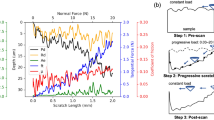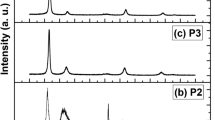Abstract
TiN and diamond-like carbon (DLC) coatings were deposited on Ti substrates with and without processing by high-pressure torsion (HPT). The HPT processing refined the grain size of titanium from the coarse-grained (CG) size of ~8.6 µm to the ultra-fine grained (UFG) size of ~130 nm and increased the hardness from ~1.83 to ~3.05 GPa. Scratch test results revealed that all the thin hard coatings had a higher critical load when deposited on the harder UFG Ti substrate compared to those deposited on the softer CG Ti. A three-dimensional finite element model (3D FEM) revealed that the improved load-carrying property of the thin hard coatings on the harder titanium substrates was related to the higher stresses generated within the substrate and its deformation behaviour which reduced the strain at the coating/substrate interface. A model based on the hardness of a two-layered composite was used to explain this effect, and it is shown that the model is reasonably successful in predicting the critical load of a wide range of coating–substrate systems. The analytical model and the results of the 3D FEM modelling emphasize the contribution of the substrate to the load-bearing capacity of thin coatings.







Similar content being viewed by others
References
Holmberg K, Matthews A (2009) Coatings tribology. Elsevier, Oxford
Oliveira VMCA, Aguiar C, Vazquez AM, Robin A, Barboza MJR (2014) Improving corrosion resistance of Ti-6Al-4V alloy through plasma-assisted PVD deposited nitride coatings. Corros Sci 88:317–327
Tkadletz M, Schalk N, Daniel R, Keckes J, Czettl C, Mitterer C (2016) Advanced characterization methods for wear resistant hard coatings: a review on recent progress. Surf Coat Technol 285:31–46
Wu G, Ding K, Zeng X, Wang X, Yao S (2009) Improving corrosion resistance of titanium-coated magnesium alloy by modifying surface characteristics of magnesium alloy prior to titanium coating deposition. Scr Mater 61:269–272
Wei QP, Yu ZM, Ma L, Yin DF, Ye J (2009) The effects of temperature on nanocrystalline diamond films deposited on WC–13wt% Co substrate with W-C gradient layer. Appl Surf Sci 256:1322–1328
Laukkanen A, Holmberg K, Koskinen J, Ronkainen H, Wallin K, Varjus S (2006) Tribological contact analysis of a rigid ball sliding on a hard coated surface, part III: fracture toughness calculation and influence of residual stresses. Surf Coat Technol 200:3824–3844
Hainsworth SV, Soh WC (2003) The effect of the substrate on the mechanical properties of TiN coatings. Surf Coat Technol 163–164:515–520
Zhang TH, Huan Y (2004) Substrate effects on the micro/nanomechanical properties of TiN coatings. Tribol Lett 17:911–916
Wang CT, Gao N, Wood RJK, Langdon TG (2011) Wear behavior of an aluminum alloy processed by equal-channel angular pressing. J Mater Sci 46:123–130. doi:10.1007/s10853-010-4862-0
Estrin Y, Vinogradov A (2013) Extreme grain refinement by severe plastic deformation: a wealth of challenging science. Acta Mater 61:782–817
Langdon TG (2013) Twenty-five years of ultrafine-grained materials: achieving exceptional properties through grain refinement. Acta Mater 61:7035–7059
Valiev RZ, Langdon TG (2006) Principles of equal-channel angular pressing as a processing tool for grain refinement. Prog Mater Sci 51:881–981
Zhilyaev AP, Langdon TG (2008) Using high-pressure torsion for metal processing: fundamentals and applications. Prog Mater Sci 53:893–979
Wang CT, Gao N, Gee MG, Wood RJK, Langdon TG (2013) Processing of an ultrafine-grained titanium by high-pressure torsion: an evaluation of the wear properties with and without a TiN coating. J Mech Behav Biomed Mater 17:166–175
Wang CT, Escudeiro A, Polcar T, Cavaleiro A, Wood RJK, Gao N, Langdon TG (2013) Indentation and scratch testing of DLC-Zr coatings on ultrafine-grained titanium processed by high-pressure torsion. Wear 306:304–310
Wang CT, Gao N, Gee MG, Wood RJK, Langdon TG (2013) Tribology testing of ultrafine-grained Ti processed by high-pressure torsion with subsequent coating. J Mater Sci 47:4742–4748. doi:10.1007/s10853-012-7110-y
Holmberg K, Laukkanen A, Ronkainen H, Wallin K, Varjus S, Koskinen J (2006) Tribological contact analysis of a rigid ball sliding on a hard coated surface: part I: modelling stresses and strains. Surf Coat Technol 200:3793–3809
Holmberg K, Laukkanen A, Ronkainen H, Wallin K, Varjus S, Koskinen J (2006) Tribological contact analysis of a rigid ball sliding on a hard coated surface: part II: material deformations, influence of coating thickness and Young’s modulus. Surf Coat Technol 200:3810–3824
Holmberg K, Laukkanen A, Ronkainen H, Wallin K (2009) Surface stresses in coated steel surfaces—influence of a bond layer on surface fracture. Tribol Inter 42:137–148
Figueiredo RB, Pereira PHR, Aguilar MTP, Cetlin PR, Langdon TG (2012) Using finite element modeling to examine the temperature distribution in quasi-constrained high-pressure torsion. Acta Mater 60:3190–3198
Stallard J, Poulat S, Teer DG (2006) The study of the adhesion of a TiN coating on steel and titanium alloy substrates using a multi-mode scratch tester. Tribol Int 39:159–166
Holmberg K, Laukkanen A, Turunen E, Laitinen T (2014) Wear resistance optimisation of composite coatings by computational microstructural modelling. Surf Coat Technol 247:1–13
Wang CT, Fox AG, Langdon TG (2014) Microstructural evolution in ultrafine-grained titanium processed by high-pressure torsion under different pressures. J Mater Sci 49:6558–6564. doi:10.1007/s10853-014-8248-6
Rodrigo A, Ichimura H (2001) Analytical correlation of hardness and scratch adhesion for hard films. Surf Coat Technol 148:8–17
Ichimura H, Ishii Y (2003) Effects of indenter radius on the critical load in scratch testing. Surf Coat Technol 165:1–7
Kamminga JD, van Essen P, Hoy R, Janssen GCAM (2005) Substrate dependence of the scratch resistance of CrNx coatings on steel. Tribol Lett 19:65–72
Rodrigo A, Perillo P, Ichimura H (2000) On the correlation of substrate microhardness with the critical load of scratch adherence for hard coatings. Surf Coat Technol 124:87–92
Burnett PJ, Rickerby DS (1987) The mechanical properties of wear resistant coatings: I: modelling of hardness behaviour. Thin Solid Films 148:41–50
Ichimura H, Rodrigo A (2000) The correlation of scratch adhesion with composite hardness for TiN coatings. Surf Coat Technol 126:152–158
Kataria S, Kumar N, Dash S, Ramaseshan R, Tyagi AK (2010) Evolution of deformation and friction during multimode scratch test on TiN coated D9 steel. Surf Coat Technol 205:922–927
Acknowledgements
Miss A. Escudeiro and Prof A. Cavaleiro of University of Coimbra, Portugal, and Dr T. Polcar of University of Southampton, U.K., are gratefully appreciated for their assistance with the DLC-Zr coatings. This work was partially supported by the EPSRC under Grant No. EP/D00313X/1, the National Science Foundation of the United States under Grant No. DMR-1160966, the Fundamental Research Funds for the Central Universities No. 30915118812 (CTW and TGL) and the VTT Technical Research Centre of Finland, Ltd.
Author information
Authors and Affiliations
Corresponding author
Ethics declarations
Conflict of Interest
The authors declare that they have no conflict of interest.
Rights and permissions
About this article
Cite this article
Wang, C.T., Hakala, T.J., Laukkanen, A. et al. An investigation into the effect of substrate on the load-bearing capacity of thin hard coatings. J Mater Sci 51, 4390–4398 (2016). https://doi.org/10.1007/s10853-016-9751-8
Received:
Accepted:
Published:
Issue Date:
DOI: https://doi.org/10.1007/s10853-016-9751-8




